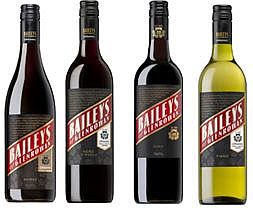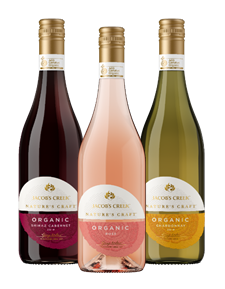Nicki Bourlioufas
As organic and biodynamic wines increasingly appear on liquor shop shelves, Australian consumers are being offered more choice from winemakers, as they play catch-up to European producers. While prices of local products are still high, they are coming down with greater supply.
In accordance with the Australian Certified Organic Standard, producers of organic wine don’t apply synthetic chemicals to the soil, vines, or wine. Organic wine contains no genetically modified (GM) ingredients. Organic wine contains minimal or no added preservatives (but can still contain some preservative sulphur dioxide).


In contrast, biodynamic wine means that the grapes are farmed biodynamically, and that the winemaker did not make the wine with any common manipulations such as yeast additions or acidity adjustments. These wines are largely unmanipulated though they can contain added sulphites.


Michael Sergeant, head of strategy and innovation at Casella Family Brands, which owns the Baileys of Glenrowan organic brand, one of Australia’s biggest organic wine producers, says in the past few years we have seen a rapidly increasing demand for organic wine in Australia. “Underpinned by consumer health and wellness trends and a growing awareness and interest in sustainable and ethically sourced products – organic wines are no longer perceived as a niche offer,” he says.
“Major retailers in Australia have been expanding their ranges in organic wines, which in turn has helped generate exposure for the category … Suppliers like Baileys have also been able to produce organic wines that are now more accessible in price, whilst maintaining consistency and quality,” he says. Bailey’s 2019 Fiano (a grape from Italy’s Campania), for example, is a full-bodied wine of great quality and length, displaying elegant stone fruit flavours, lemon, and mineral notes with aging in wood and maturation on its lees adding complexity to the wine. The 2016 Shiraz ($27) is a sustainable wine of great character with intense savoury red fruits, well-integrated French oak and, at 13.5% alcohol, avoiding too much, a problem with many Australian wines. Indeed, Baileys’ whole organic range was the one that impressed me most for its quality and relative value.
“We are currently experiencing double digit growth across retail sales in organic wines (almost 50% in the sub $20 tiers) and with the pandemic, a sharp rise in online sales of organic wines has also been observed for both existing and new brands,” says Sergeant.
Playing catchup to Europe
In contrast to Australia, the market in Europe is well established for organic wines – in countries like France and Italy, biodynamic and organic wines have been mainstream for some years.


Dan Swincer, chief winemaker at brand label Jacob’s Creek, says the brand has sold organic wines in Nordic countries for almost a decade and has recently released the Jacob’s Creek Nature’s Craft organic wine range in Australia.
“Looking at the category in general, it seems that people across a wide age spectrum, particularly those who are younger and more sustainably conscious, are becoming more interested in the products they buy, how it is made and if they are sustainable,” says Swincer.
Consumers still learning the benefits


To ensure a product is genuinely organic, the wine should be ‘certified organic’ by an organic certifying body approved by Australia’s Department of Agriculture and Water Resources. Consumers should check for a certification logo, such as ACO (Australian Certified Organic) or NASA (National Association for Sustainable Agriculture). Baileys of Glenrowan is the largest ACO organic wine producer, though many others are joining the list.
Mark Davidson, managing director and winemaker at Tamburlaine Organic Wines, which makes wines from the Hunter Valley and Orange, says consumers are quickly discovering expanding organic wine options. “Not that long ago this was certainly not the case. The ability to choose organic wine from a broad range of premium regions will also be a very important step in expanding the number of Aussie consumers who buy organic wine,” he says.
“There is still some general ignorance amongst consumers about what organic means – gradually however the word is getting out. Confusion about poor shelf life (based the idea that organic means no protective use of sulphur at all) needs to be cremated,” says Davidson.
Wines made from organic grapes can include added sulphites, but the grapes must be certified organically grown. “Other than organically certified grapes, most ingredients we use in organic winemaking are the pretty much the same as for non-organic wines, although each has to comply with the National Organic Standard,” says Davidson.
According to Troy Kalleske, of Kalleske in the Barossa Valley, winemakers are permitted only to add a maximum of 125ppm (parts per million) sulphur dioxide for organic wines compared to 250ppm for normal wines. In contrast, in the US, certified organic wines can contain virtually no sulfites at all. Their EU counterparts can contain up to 100ppm of sulfites. Kalleske’s own vineyards are low yielding with grapes grown organically and biodynamically and the winery is also certified biodynamic/organic.
Tamburlaine’s Davidson has added several “preservative free” wines to the winery’s organic range in recent years – or wines with no added sulphur, given natural preservatives exist in wine such as alcohol and acid. The winery’s range of organic wines is extensive, including its Reserve collection, with prices starting from $28.50 for the wines which include the excellent 2019 Fume Blanc, or barrel aged Sauvignon Blanc, and 2019 Reserve Cabernet Sauvignon, both from Orange, in NSW Australia.


Price can be a barrier
According to one of Australia’s largest wine retainer, Dan Murphy’s, organic wine is similarly priced to conventional wine. But that’s not really the case and often local wines can still be pricey. Not everyone can afford to spend $20-$30 on organic wine.
Jacob’s Creek Nature’s Craft Organic range is priced at $20 a bottle, around $10 more expensive than regular Jacob’s Creek wines – and whereas the Jacob’s Creek stands out for great value and good clean flavours, the Nature’s Craft Organic Chardonnay and Shiraz Cabernet (RRP$19.99) wines don’t – both had aftertastes and lacked character. So they may well be a work in progress. The brand is owned by French giant Pernod Ricard, which is expanding its organic range of wines to meet demand and perhaps still getting the balance right.
Supermarket ALDI’s buying manager Jason Boywer says many local organic wines can be overpriced and underwhelming. So, to make things affordable, they sell the AC Byrne McLaren Vale Organic and Biodynamic Shiraz 2019 for $9.99 and Vinology McLaren Vale Organic Biodynamic Cabernet Sauvignon 2020 for $11.99.
ALDI recently offered one of the author’s favourites, the Tavernello Organic Sangiovese Rubicone IGT 2018. Its $7 price tag can mislead since the wine is of a high quality with clean berry flavours decent character, despite being produced by a large winery in Italy, or perhaps because of it. ALDI has also sold the El Toro Macho Organico (Tempranillo) for $7, so the supermarket’s buying power can benefit local wine drinkers.


Other good value organic wines I discovered were the Grancari Estate Wines produced by the McLaren Vale certified organic winery in South Australia. Its Shiraz and Grenache wines and Rhone Valley style blends are made organically are made from mature vines, with some vines dating from the 1940s. New and old French and American oak are used to mature the organic wines, which sell for between $10-$20 a bottle. A favourite of mine was the preservative-free organic 2018 Grenache Shiraz ($15), also available preservative-free for the same price.
In Victoria, Baileys of Glenrowan boasts 143 hectares (353 acres) of organic vineyards in north-eastern Victoria planted with varieties best suited to the region – Shiraz, Durif, Muscat and Muscadelle. Certified organic in 2011, Baileys adopted organic farming practices early in Australia. From vintage 2019, all of Baileys of Glenrowan table wines have been organically grown and produced, without synthetic chemicals, sprays, fertilisers, herbicides, pesticides, or any other products that are not naturally occurring.
Its range includes a new release Italian variety 2019 Nero D’Avola (RRP $20) and 2019 Fiano ($20) which join a 2016 Shiraz ($27), 2017 Durif ($27) and 2019 Small Batch Rosé ($20). The 2016 Shiraz in particular bucks the Australian trend to release red wines before they are ready, then to charge a premium for them. The 2019 Fiano is layered and textured with hints of almond, white peach with a clean crisp finish.
Biodynamic and organic wines are not the same
While organic viticulture demands no synthetic chemicals or artificial fertilisers are used in the vineyard, biodynamics production of wine is an organic holistic method of farming based on the work of Austrian philosopher Rudolf Steiner. In addition to good organic practices such as composting, biodynamic farming relies on special plant, animal and mineral preparations and the rhythmic influences of the sun, moon, planets and stars.
Stefano Lubiana, vigneron and founder of Stefano Lubiana Wines, says demand for biodynamic wine is growing slowly in Australia, with organic wine growing a little faster. In contrast to Australia, in many Europe countries such as France, biodynamic wines are more common than organic wines. Typically, the rules are less strict than for organic wine production.
“Most people don’t know about biodynamics in general. Biodynamic wine is made from biodynamic grapes which have been grown with biodynamic preparations according to Rudolph Steiner,” says Lubiano.
“Both systems benefit the environment by not using synthetic chemicals and by working with nature in the vineyard.”
